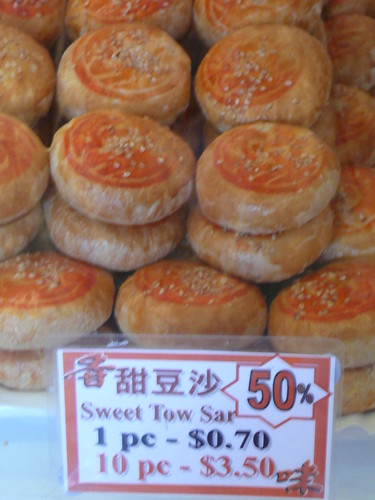
Sexbomb sex bomb, you're my sex bomb
You can give it to me when I need to come along
Sexbomb sex bomb you're my sex bomb
And baby you can turn me onTom Jones, Sex Bomb
People who know me appreciate that I'm not a sweet tooth. They also know that I'm an intuitive cook, not a baker - not a person who is systematic in checking weights and balances, following recipes to the nth detail. Curiously often - I won't say annoyingly, as I don't mind being challenged - I find myself being requested to make dessert when invited to dinner.
Neither Mr Sticki or I eat dessert at home, though he does claim that he has a separate stomach just for ice cream - making it possible to eat it even when he's stuffed to the gills. I on the other hand, am rarely tempted and will often choose cheese instead. If George Biron had not had Hungarian pancakes on the dessert menu last week, when we visited Sunnybrae, I would have chosen the savoury dessert option of black and white pudding.
I have, however acquired a taste for Asian desserts. I'm Eurasian so I guess this is fair enough, given the kooky nature of Asian sweets. Sugar came to the world from China but it is hardly a world of sweets. In fact most Chinese snacks are savoury, not sweet, and many of the desserts are soups, with a touch of sugar. In fact, with the exception of Indian sweets, the majority of Asian desserts are not excessively sugary.
Of the Asian sweets I love, topping my list recently was the Mamak Roti Tissu (image by Chocolate Suze); a cone of gossamer thin pastry laced with sweetened condensed milk and margarine, that fuses on a blistering hotplate to become a crisp caramelised cone of decadence, up to two feet in height.
And then it was joined by Roti Bom.
Roti Bom (pictured at the top of this post) consists of a two inch thick disc of roti bread, again drenched in condensed milk and margarine. The sticky emulsion is poured onto the bread as it cooks, soaking into the body of the pastry and providing a glossy caramel finish. It's cake-like, it's sweet tempered with a little salt. It's slightly burnt, with crisp edges and it is a sensational finish to a meal. In short it's sexy, voluptuous and marvelous, especially when taken with a nice polystyrene cup of Teh Tarik - spiced sweet tea with more condensed milk, poured from a great height to produce foam on top.
Recently while in Singapore my dear friend Bin took us to a Traditional Chinese Dessert venue in Temple Street, Chinatown. The bustling business was on the ground floor of an old Chinese shop house, furnished with camphor wood stools and tables. Outside the street was lined with cars, crowds and the clamour of day to day life in hot and humid surrounds. The laminated menu consisted of many sweet Asian delights such as Chendol, sweet almond soup, mango pudding with sago, fresh tofu and lurid displays of Ice Kachang, furnished with beans, corn, grass jelly and rose syrup poured over shaved ice.
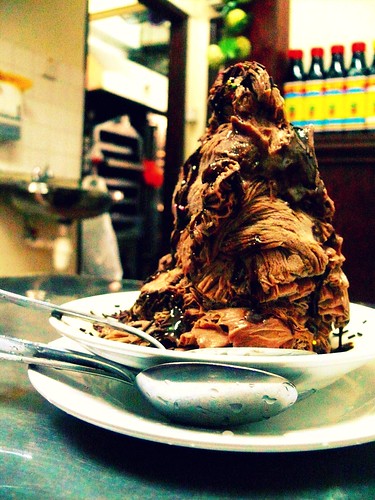
We had just had the fish head curry you read about in the last post, and so feeling pretty full, we ordered just a few things. For the man who always has room for ice cream, a tall mound of shaved ice drenched in chocolate syrup hit the spot. It looked to all intents like a massive icy turd, but it made him happy given the heat of the day, compounded by a boiling, chilli laden fish head curry.

I ordered coconut jelly - a childhood favourite - and a single pineapple pastry. These pastries are famous in Singapore and the waitress was aghast when I said I only wanted one. I had to blame it on the fish head curry and from food fatigue. Just days before, we had been eating eight times a day whilst visiting Mr Chew in Penang.
The coconut jelly is often seen on yum cha carts. It is simply coconut milk, set with agar-agar, made in trays and served chilled. Each portion is a one inch square opaque white cube. On a hot day it's refreshing and not the slightest bit filling. It slips cool, smooth and delicious over your tongue. In particular it soothes the burning hell that your oral cavity may have become during the lethal onslaught of a cavalcade of chilli and spices. I'm also a fan of the lurid green striped lime jellies that alternate layers of coconut and lime jelly.
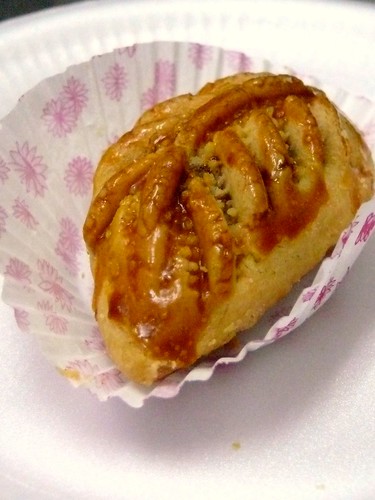
So, on to the popular Singaporean pineapple pastry, it's made with a very short pastry common to China. The Chinese mainland not being a country particularly endowed with dairy products, traditional Chinese pastries are made with lard and hot water - unlike the Vietnamese delights, influenced by the French method of shortening pastry with butter. So the pastry around the famous Singaporean pineapple sweet is very flaky with a flavour distinctly different to butter pastry. The pineapple filling is more like an intense jam, and at two bites, it was just enough of a sweet hit for me. The same pastry is used on Chinese custard tarts and dim sum items such as cha sui soh - BBQ pork pies.
This same pastry was wrapped around a morsel we ate in Penang recently. Though sweet, it was a savoury dish, and not something I had eaten since I was a child, when dining with my grandfather at his usual reserved table at Luk Yu Tea House in Hong Kong.
This time, we ate this delicacy at a Chieu Chao (aka Teochew) dim sum restaurant in Georgetown, Penang, around the corner from Campbell street. The nostalgia it brought back was immense. I instantly pictured my wrinkled, bald, little Oriental grandfather in one of his many dapper three pieced, pin striped suits, laughing with his cronies at lunch.
The delicious item in question is something that I've never seen in Melbourne on dim sum carts. You take a rod of pork fat and wrap it with a slice of rich duck liver cooked in Cha Sui marinade and barbecued. Then add a piece of Cha Sui - lean shoulder pork cooked in the same marinade and wrap the lot in Chinese flaky pastry; eggwash, then bake until golden.
The whole effect is rich, sweet, savoury and fatty. The sweetness is formed by the BBQ marinade that is a mix of maltose and fermented sweetened bean paste. As much as I adore these beautiful little parcels of excess, I felt as though I ought to order a stent for the arteries that begin to close over while digesting items such as this. Copious amounts of Chinese tea neutralised the fatty residue in my mouth and allayed my guilt temporarily. But it's really no wonder that my Grandfather had angina related problems.
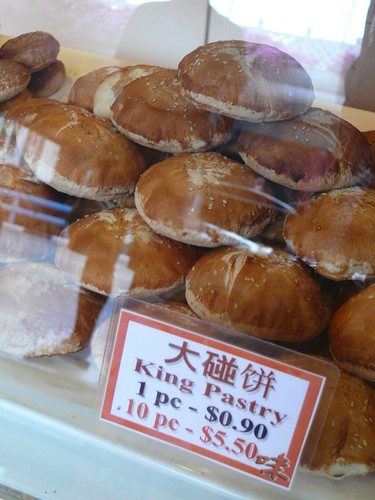
At the heart of this dim sum delight is the seed of why I don't revere sweets. The Chinese dining philosophy is to mix savoury with sweet and with sour, with hot and cold in the selection of dishes served at meal time. Along with that is a fundamental need for all meals to have a mixture of textures. Hence desserts like sweet syrupy soups containing crunchy savoury snow fungus and lotus root or lotus seeds. Or Chinese doughnuts (above) that are only vaguely sweet, designed to be dipped in congee, herbal soups or braises. And then there are my favourite snacks - Asian pork jerky made from bacon that is savoury from Nam Yu - fermented red bean paste - smoky & charred from the drying process and finished with sticky, sweet maltose.
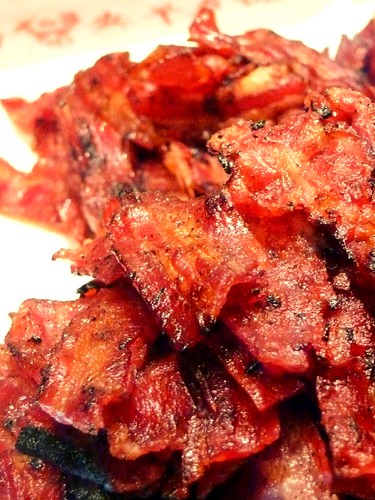
The other reason that I'm not fussed by sweets is that on a few occasions I have been tested positively as a 'Supertaster' by researchers at a couple of Universities. A Supertaster is one who has more taste buds than average. So I perceive flavours more intensely than most. Some chemicals in food 'burn' my tongue. Broad beans and certain bitter foods make my tongue ache and hurt. Sweet things can seem too cloying and make my eyes water.
So, why do I favour Asian sweets over European style sweets? The secret is that they often contain a savoury element, or do not embellish a naturally sweet ingredient. So while I can cope with the occasional vanilla slice or Sacher Torte, I'd rather bring on the Roti Bom.
Roti Bom, Roti Bom - you're my sex bomb....oooh and baby you can turn me on!
Neither Mr Sticki or I eat dessert at home, though he does claim that he has a separate stomach just for ice cream - making it possible to eat it even when he's stuffed to the gills. I on the other hand, am rarely tempted and will often choose cheese instead. If George Biron had not had Hungarian pancakes on the dessert menu last week, when we visited Sunnybrae, I would have chosen the savoury dessert option of black and white pudding.
I have, however acquired a taste for Asian desserts. I'm Eurasian so I guess this is fair enough, given the kooky nature of Asian sweets. Sugar came to the world from China but it is hardly a world of sweets. In fact most Chinese snacks are savoury, not sweet, and many of the desserts are soups, with a touch of sugar. In fact, with the exception of Indian sweets, the majority of Asian desserts are not excessively sugary.
Of the Asian sweets I love, topping my list recently was the Mamak Roti Tissu (image by Chocolate Suze); a cone of gossamer thin pastry laced with sweetened condensed milk and margarine, that fuses on a blistering hotplate to become a crisp caramelised cone of decadence, up to two feet in height.
And then it was joined by Roti Bom.
Roti Bom (pictured at the top of this post) consists of a two inch thick disc of roti bread, again drenched in condensed milk and margarine. The sticky emulsion is poured onto the bread as it cooks, soaking into the body of the pastry and providing a glossy caramel finish. It's cake-like, it's sweet tempered with a little salt. It's slightly burnt, with crisp edges and it is a sensational finish to a meal. In short it's sexy, voluptuous and marvelous, especially when taken with a nice polystyrene cup of Teh Tarik - spiced sweet tea with more condensed milk, poured from a great height to produce foam on top.
Recently while in Singapore my dear friend Bin took us to a Traditional Chinese Dessert venue in Temple Street, Chinatown. The bustling business was on the ground floor of an old Chinese shop house, furnished with camphor wood stools and tables. Outside the street was lined with cars, crowds and the clamour of day to day life in hot and humid surrounds. The laminated menu consisted of many sweet Asian delights such as Chendol, sweet almond soup, mango pudding with sago, fresh tofu and lurid displays of Ice Kachang, furnished with beans, corn, grass jelly and rose syrup poured over shaved ice.

We had just had the fish head curry you read about in the last post, and so feeling pretty full, we ordered just a few things. For the man who always has room for ice cream, a tall mound of shaved ice drenched in chocolate syrup hit the spot. It looked to all intents like a massive icy turd, but it made him happy given the heat of the day, compounded by a boiling, chilli laden fish head curry.

I ordered coconut jelly - a childhood favourite - and a single pineapple pastry. These pastries are famous in Singapore and the waitress was aghast when I said I only wanted one. I had to blame it on the fish head curry and from food fatigue. Just days before, we had been eating eight times a day whilst visiting Mr Chew in Penang.
The coconut jelly is often seen on yum cha carts. It is simply coconut milk, set with agar-agar, made in trays and served chilled. Each portion is a one inch square opaque white cube. On a hot day it's refreshing and not the slightest bit filling. It slips cool, smooth and delicious over your tongue. In particular it soothes the burning hell that your oral cavity may have become during the lethal onslaught of a cavalcade of chilli and spices. I'm also a fan of the lurid green striped lime jellies that alternate layers of coconut and lime jelly.

So, on to the popular Singaporean pineapple pastry, it's made with a very short pastry common to China. The Chinese mainland not being a country particularly endowed with dairy products, traditional Chinese pastries are made with lard and hot water - unlike the Vietnamese delights, influenced by the French method of shortening pastry with butter. So the pastry around the famous Singaporean pineapple sweet is very flaky with a flavour distinctly different to butter pastry. The pineapple filling is more like an intense jam, and at two bites, it was just enough of a sweet hit for me. The same pastry is used on Chinese custard tarts and dim sum items such as cha sui soh - BBQ pork pies.
This same pastry was wrapped around a morsel we ate in Penang recently. Though sweet, it was a savoury dish, and not something I had eaten since I was a child, when dining with my grandfather at his usual reserved table at Luk Yu Tea House in Hong Kong.
This time, we ate this delicacy at a Chieu Chao (aka Teochew) dim sum restaurant in Georgetown, Penang, around the corner from Campbell street. The nostalgia it brought back was immense. I instantly pictured my wrinkled, bald, little Oriental grandfather in one of his many dapper three pieced, pin striped suits, laughing with his cronies at lunch.
The delicious item in question is something that I've never seen in Melbourne on dim sum carts. You take a rod of pork fat and wrap it with a slice of rich duck liver cooked in Cha Sui marinade and barbecued. Then add a piece of Cha Sui - lean shoulder pork cooked in the same marinade and wrap the lot in Chinese flaky pastry; eggwash, then bake until golden.
The whole effect is rich, sweet, savoury and fatty. The sweetness is formed by the BBQ marinade that is a mix of maltose and fermented sweetened bean paste. As much as I adore these beautiful little parcels of excess, I felt as though I ought to order a stent for the arteries that begin to close over while digesting items such as this. Copious amounts of Chinese tea neutralised the fatty residue in my mouth and allayed my guilt temporarily. But it's really no wonder that my Grandfather had angina related problems.

At the heart of this dim sum delight is the seed of why I don't revere sweets. The Chinese dining philosophy is to mix savoury with sweet and with sour, with hot and cold in the selection of dishes served at meal time. Along with that is a fundamental need for all meals to have a mixture of textures. Hence desserts like sweet syrupy soups containing crunchy savoury snow fungus and lotus root or lotus seeds. Or Chinese doughnuts (above) that are only vaguely sweet, designed to be dipped in congee, herbal soups or braises. And then there are my favourite snacks - Asian pork jerky made from bacon that is savoury from Nam Yu - fermented red bean paste - smoky & charred from the drying process and finished with sticky, sweet maltose.

The other reason that I'm not fussed by sweets is that on a few occasions I have been tested positively as a 'Supertaster' by researchers at a couple of Universities. A Supertaster is one who has more taste buds than average. So I perceive flavours more intensely than most. Some chemicals in food 'burn' my tongue. Broad beans and certain bitter foods make my tongue ache and hurt. Sweet things can seem too cloying and make my eyes water.
So, why do I favour Asian sweets over European style sweets? The secret is that they often contain a savoury element, or do not embellish a naturally sweet ingredient. So while I can cope with the occasional vanilla slice or Sacher Torte, I'd rather bring on the Roti Bom.
Roti Bom, Roti Bom - you're my sex bomb....oooh and baby you can turn me on!
